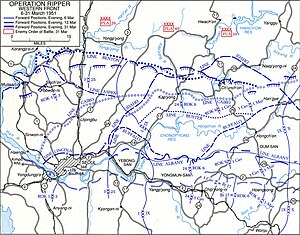This article relies largely or entirely on a single source. (May 2023) |
| Operation Ripper | |||||||
|---|---|---|---|---|---|---|---|
| Part of the Korean War | |||||||
 Operation Ripper western front map | |||||||
| |||||||
| Belligerents | |||||||
|
|
| ||||||
| Commanders and leaders | |||||||
|
|
| ||||||
| Casualties and losses | |||||||
|
Total unknown 3,220 wounded[2] | 7,151 known dead; Thousands killed, wounded and captured | ||||||
Operation Ripper, also known as the Fourth Battle of Seoul, was a United Nations (UN) military operation conceived by the US Eighth Army, General Matthew Ridgway, during the Korean War. The operation was intended to destroy as much as possible of the Chinese People's Volunteer Army (PVA) and Korean People's Army (KPA) forces around Seoul and the towns of Hongch'on, 50 miles (80 km) east of Seoul, and Chuncheon, 15 miles (24 km) further north. The operation also aimed to bring UN troops to the 38th Parallel. It followed upon the heels of Operation Killer, an eight-day UN offensive that concluded February 28, to push PVA/KPA forces north of the Han River. The operation was launched on 6 March 1951 with US I Corps and IX Corps on the west near Seoul and Hoengsong and US X Corps and Republic of Korea Army (ROK) III Corps in the east, to reach the Idaho Line, an arc with its apex just south of the 38th Parallel in South Korea.
Operation Ripper was preceded by the largest artillery bombardment of the Korean War. In the middle, the US 25th Infantry Division quickly crossed the Han and established a bridgehead. Further to the east, IX Corps reached its first phase line on 11 March. Three days later the advance proceeded to the next phase line. During the night of 14–15 March, elements of the ROK 1st Infantry Division and the US 3rd Infantry Division liberated Seoul, marking the fourth and last time the capital changed hands since June 1950. The PVA/KPA forces were compelled to abandon it when the UN approach to the east of the city threatened them with encirclement.
Following the recapture of Seoul the PVA/KPA forces retreated northward, conducting skilful delaying actions that utilized the rugged, muddy terrain to maximum advantage, particularly in the mountainous US X Corps sector. Despite such obstacles, Operation Ripper pressed on throughout March. In the mountainous central region, US IX and US X Corps pushed forward methodically, IX Corps against light opposition and X Corps against staunch enemy defenses. Hongch'on was taken on the 15th and Chuncheon secured on the 22nd. The capture of Chuncheon was the last major ground objective of Operation Ripper.
UN forces had advanced north an average of 30 miles (48 km) from their start lines. However, while the Eighth Army had occupied their principal geographic objectives, the goal of destroying PVA forces and equipment had again proved elusive. More often than not, the PVA/KPA forces withdrew before they suffered extensive damage. Chuncheon, a major PVA/KPA supply hub, was empty by the time UN forces finally occupied it. As the UN troops ground forward, they were constantly descending sharp slopes or ascending steep heights to attack enemy positions that were sometimes above the clouds. By the end of March, US forces reached the 38th Parallel.
- ^ Bercuson, David J. (1999). Blood on the Hills: The Canadian Army in the Korean War. University of Toronto Press. pp. 92–66. ISBN 0802009808.
- ^ Varhola, Michael J. (2000). Fire and Ice: The Korean War, 1950–1953. Da Capo Press. p. 19.
© MMXXIII Rich X Search. We shall prevail. All rights reserved. Rich X Search
